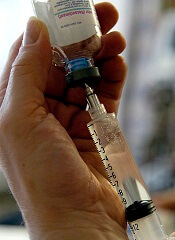
In a survey of 200 adults with hemophilia A, most were not aware that factor VIII (FVIII) products can be stored at room temperature.
A majority of patients surveyed thought FVIII products must be stored in the refrigerator at all times.
The minority of
patients who did store FVIII at room temperature felt significantly
more satisfied with their treatment and less restricted in their daily
lives than patients who refrigerated FVIII.
“People living with hemophilia A can feel restricted in their daily life based on the misconception that all FVIII treatments must be stored in the refrigerator,” said Mariasanta Napolitano, MD, of the University of Palermo in Italy.
“It is important that healthcare professionals communicate to patients that some FVIII products can be used portably and at room temperature, to enable them to go about their daily lives as actively as they wish.”
Dr Napolitano and her colleagues presented the results of this survey at the 10th Annual Congress of the European Association for Haemophilia and Allied Disorders (EAHAD, poster P024).
The researchers conducted the survey in adults with hemophilia A in 7 countries. Face-to-face surveys were conducted with 90 people in the European Union (France, Italy, and UK) and 90 people in Latin America (Argentina, Brazil, and Mexico). Online surveys were conducted with 20 people in Japan.
The questionnaire covered current use of FVIII products, patient satisfaction, and restrictions in daily life using verbalized rating scales (eg, “not restricted at all / somewhat restricted / restricted / strongly restricted”).
Seventy-four percent of patients used FVII as prophylaxis, and 26% used on-demand treatment. Sixty-seven percent used recombinant FVIII, and 33% used plasma-derived FVIII.
Storage
Most patients—85%—stored their FVIII product in the refrigerator, with 15% storing their treatment at room temperature.
Of those storing FVIII in the refrigerator, 88% said FVIII must be stored in the refrigerator at all times. Seventy-nine percent of patients said they worry about the temperature at which FVIII is stored.
Seventy-four percent said they wait for their FVIII product to reach room temperature before mixing and injecting it. The median wait time was 10 minutes.
Sixty-two percent of patients said an injection with cold FVIII is more unpleasant than an injection with room temperature FVIII.
Satisfaction
Patients storing FVIII at room temperature were significantly more likely than those storing FVIII in the refrigerator to report overall satisfaction with their FVIII product (52% vs 28%, P<0.05).
Patients storing FVIII at room temperature were also significantly more likely to report satisfaction with:
- Product efficacy (61% vs 43%, P<0.05)
- The procedure of mixing the product before injection (39% vs 22%, P<0.05)
- The flexibility of storage depending on the patients’ needs (55% vs 18%, P<0.05)
- The length of time the product can be stored outside the refrigerator (45% vs 19%, P<0.05)
- The size of vials (42% vs 18%, P<0.05)
- Storage temperature (39% vs 15%, P<0.05).
Daily life
Patients storing FVIII at room temperature travelled significantly more often—16 times per year vs 9 times per year (P<0.01).
Nineteen percent of these patients felt that storing, preparing, and mixing FVIII is disruptive to the normal course of the day, compared to 35% of patients who store FVIII in the refrigerator (P<0.05).
Significantly fewer patients in the room-temperature group said they feel restricted when it comes to sports activities, traveling, and their evening routine (P<0.05).
Forty-eight percent of patients storing FVIII at room temperature said they feel relaxed using FVIII in their daily life, compared to 20% of patients storing FVIII in the refrigerator (P<0.05).


